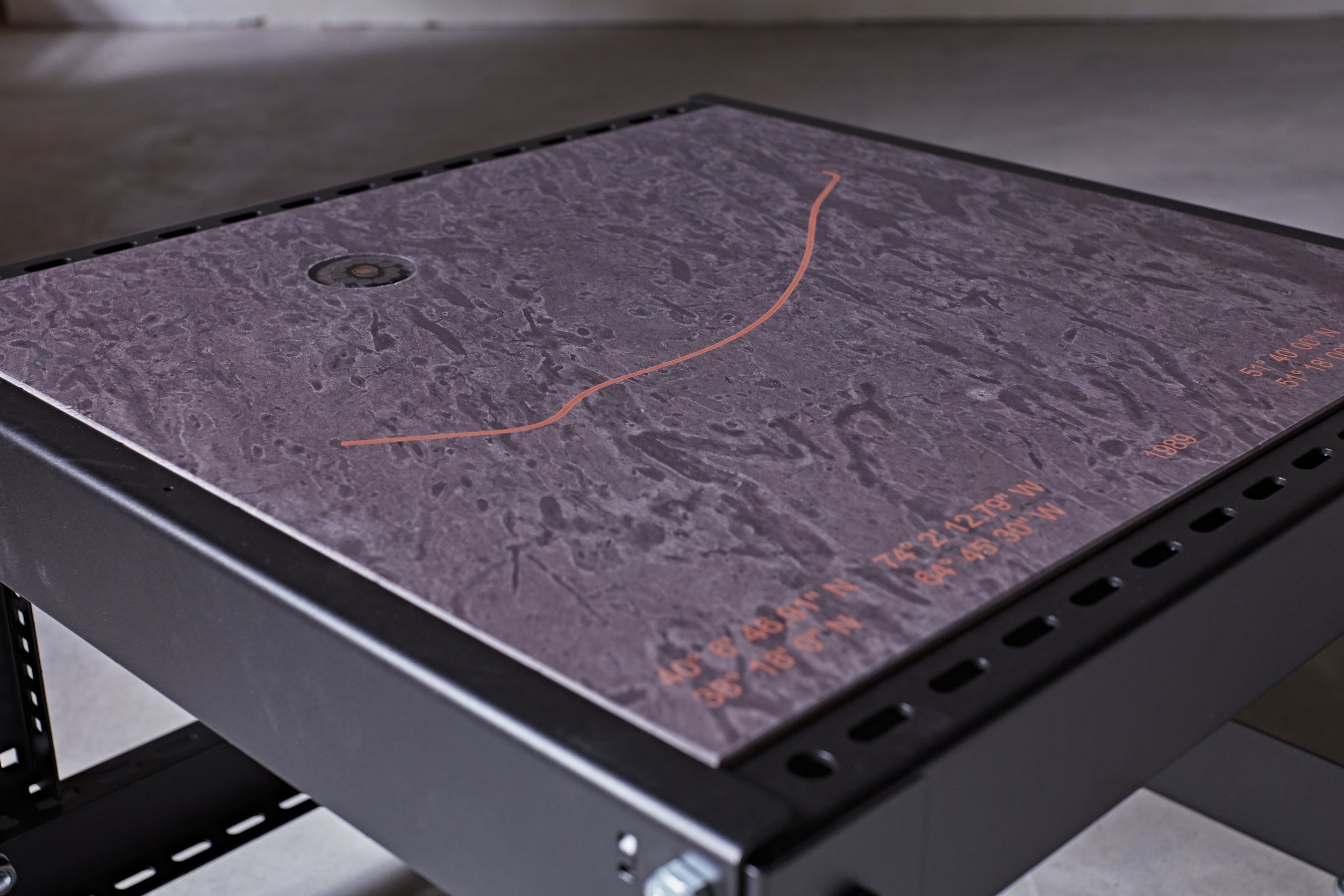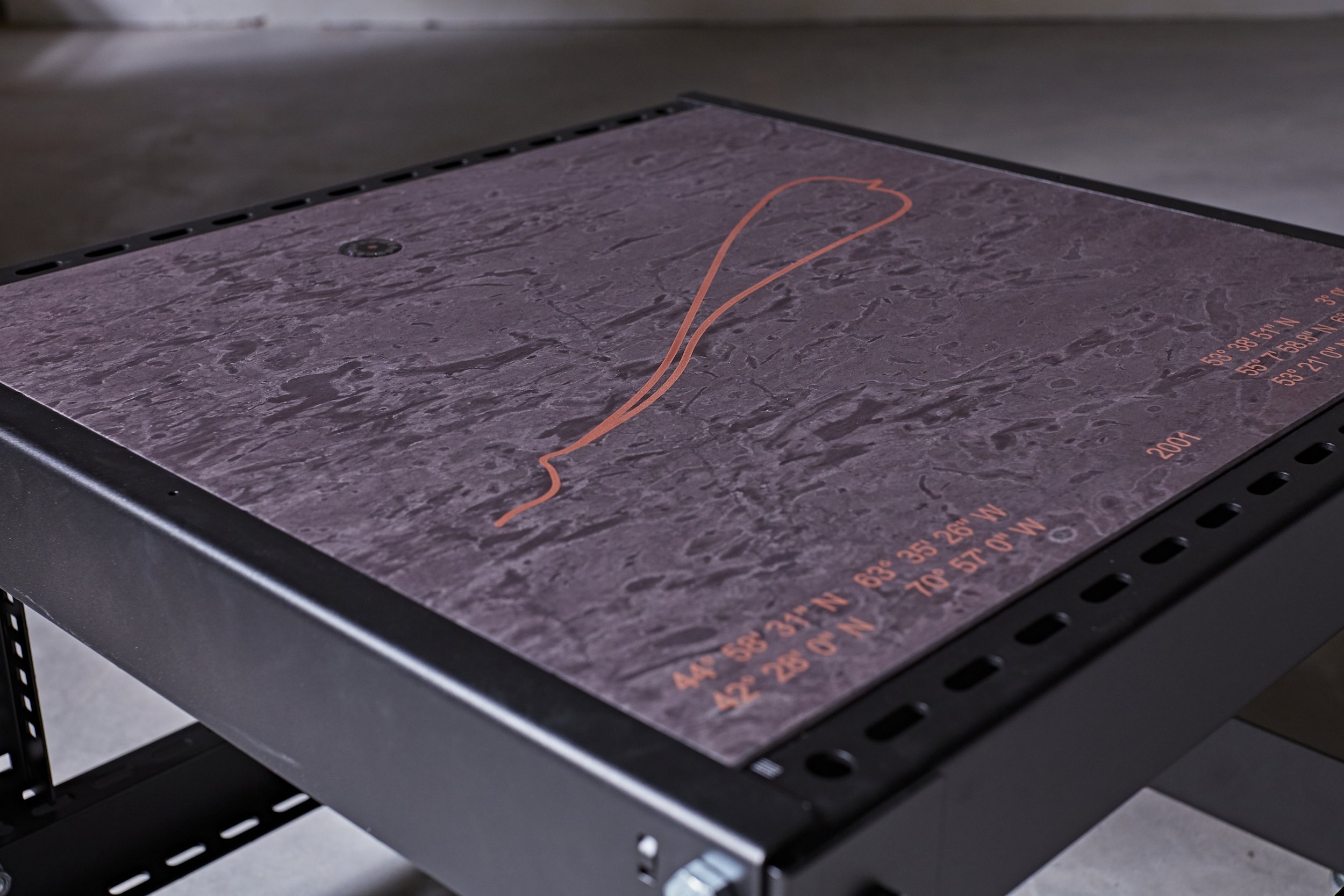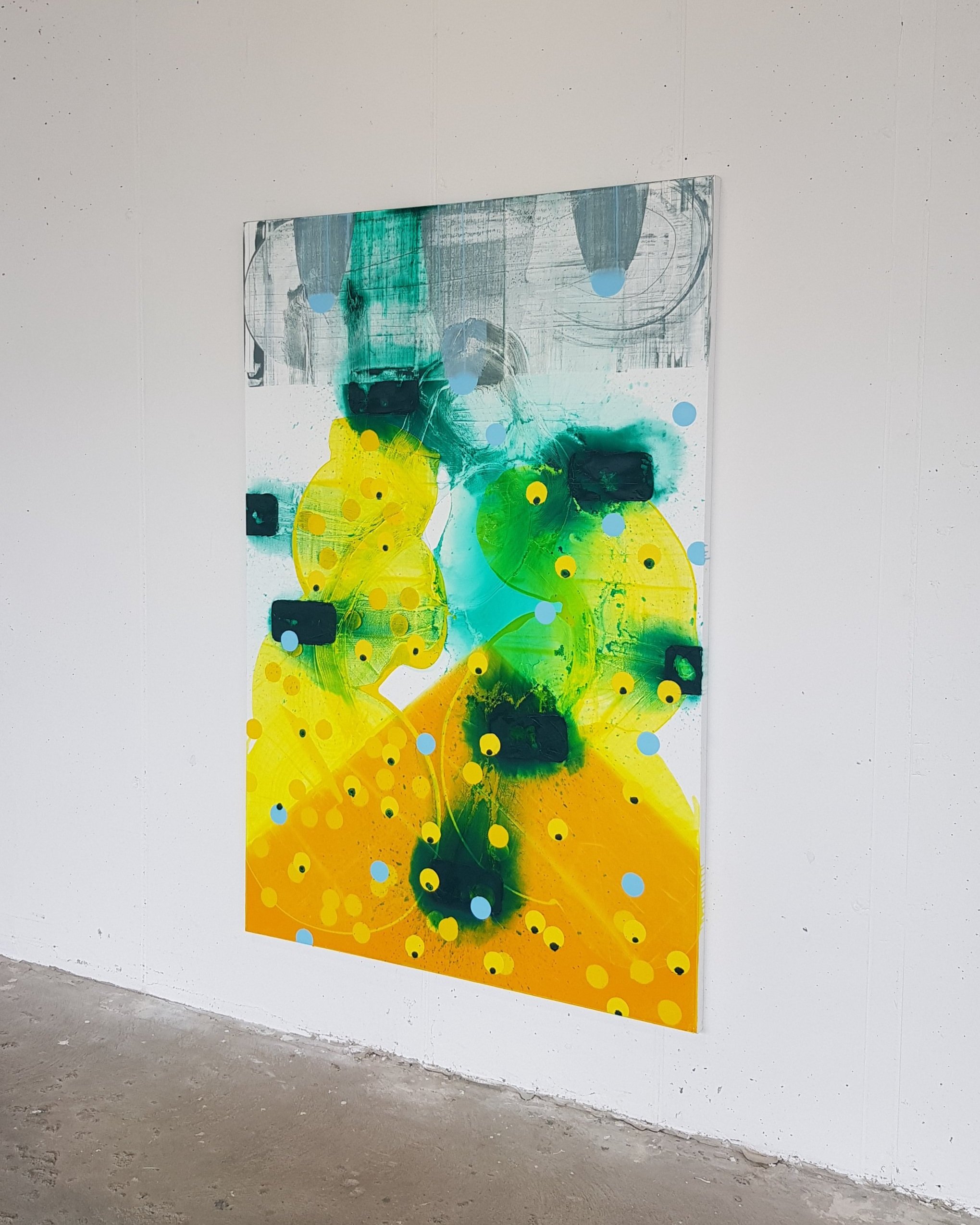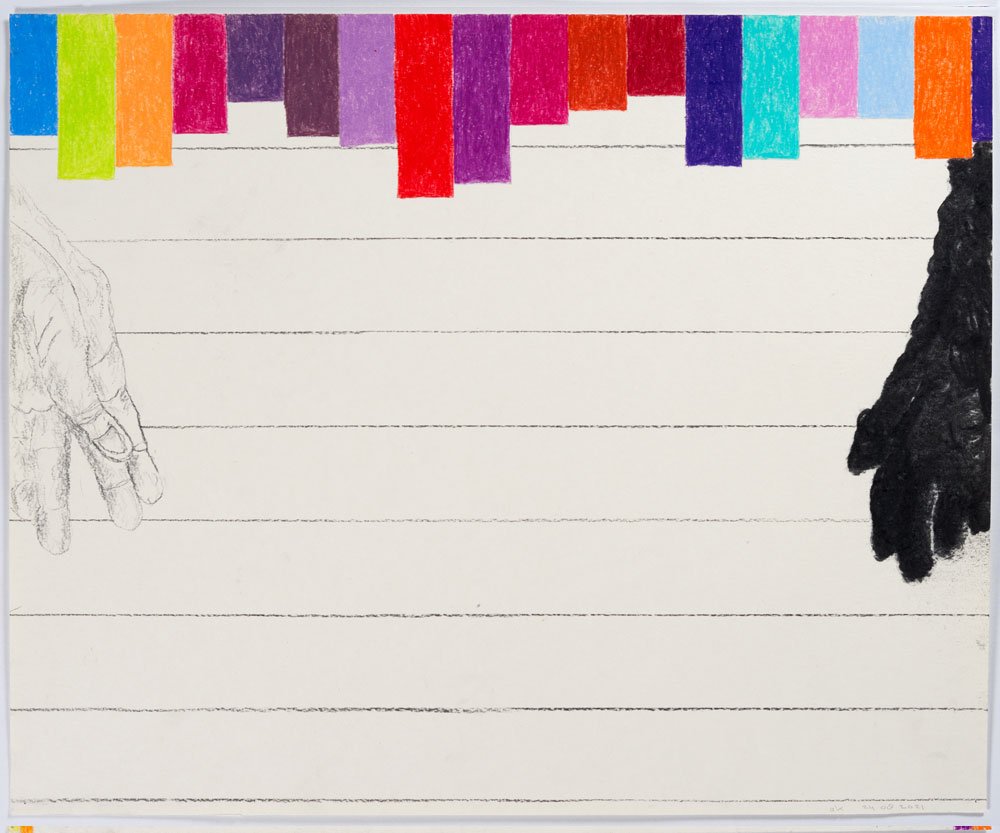Drawing It Out
Group Exhibition
ANNEX Kirstin Arndt Alan Butler John Cronin
Damien Flood Mark Joyce Arno Kramer
Caroline McCarthy Niamh McCann Fergus Martin
Peter Piller Bridget Riley Nigel Rolfe
13th July - 25th August
Drawing It Out,
is the title of Green On Red Gallery's summer 2023 exhibition featuring new and recent work by gallery and invited artists in multiple media. The exhibition opens on Thursday, 13 July and runs to the end of August. While the title suggests the medium of drawing - the root and beginning of many artists' practices - it also can have nothing to with works on paper or even work that is hand-wrought. The viewer is invited to ' work it out ' to arrive at a clear grasp of the painting, photograph, drawing or installation in front of them. Typically in Drawing it Out the viewing is amplified and extended in a multitude of ways.
We are delighted to be showing for the first time in Ireland, new photographic work and drawings by German artist Peter Piller.
Working with photography and drawing since the 1990s, Piller has used various visual material and its subsequent re-contextualisation to create works with new meanings and dimensions. Over his career he has created a vast inventory of images and photos, ultimately The Peter Piller Archive, from the internet, magazines, postcards, and aerial photographs. With precise observation and a subtle sense of humour he then organises, categorises and assembles them into new series. Through the reworking and representation of his chosen images the artist draws attention to their multiple significations and the potential latent relationships and rhyming between them. These new formations offer insightful perspectives and answers to many questions, though these answers often then lead to new questions.
Piller's drawings are often made in response to casual photographs taken on walks or peripatetic circles he makes. They couldn't be further from maps or documentation but are more like an emotional field of marks.
Recently Piller has taken a deep interest in European prehistoric cave paintings created before humans became sedentary. In an interview with Barbara Wien he states, "...everything I see is to do with caves. And it's because everything is also being looked at regarding its possible communication with this enigmatic prehistoric art which we will never understand; we can only speculate about it. I find this challenging and relevant to the present: cautious assumption, insight through delving into questioning oneself instead of clear mentally dictated announcements."
Piller was born 1968 in Fritzlar and currently lives and works in Hamburg, Germany. He is a professor of fine art at the Kunstakademie Düsseldorf and is represented by galleries Capitain Petzel and Barbara Wien in Berlin and Andrew Kreps Gallery, New York
Peter Piller there are a couple of things that bother me at the Kunsthalle Düsseldorf, Spring 2023 Katja Illner © VG Bild-Kunst, Bonn 2023
Peter Piller Hoe 39 2022 Two pigment print, framed 60 x 44cm © Peter Piller, Courtesy the artist and Capitain Petzel
Peter Piller FHO 50 2023 Pigment print, unframed 48 x 33cm © Peter Piller, Courtesy the artist and Capitain Petzel
Special thanks to Capitain Petzel Gallery, Berlin and to the artist.
Bridget Riley Composition with Circles 5 2005 Graphite, acrylic and permanent marker on plaster wall 606 x 757.5 cm Photo: Max Hetzler Gallery
Drawing has been a crucial part of Riley's practice for more than six decades. It is evident in her recent flowering of wall paintings seen in The British School, Rome and, a little more playfully but equally monumentally in her current exhibition Wall Works 1983 - 2023 at Max Hetzler Gallery, Berlin. It was the focus of Bridget Riley Drawings : From the Artist's Studio, retrospective exhibition earlier this year in the Hammer Museum, Los Angeles, USA travelling to the Morgan Library Museum, New York from June to September of this year with the Art Institute, Chicago. Riley's unceasing commitment to paper, pencil, ink, and gouache, as tools of exploration and innovation is seen throughout the exhibition. The artist reflected on this commitment in a conversation with Sir John Leighton. Speaking about the act of making visible she quotes French painter Eugène Boudin speaking to a novice Claude Monet saying " learn to draw ... learn to see ! " Riley continues to speak about the importance of drawing when discussing Seurat's work stating : " Feeling with one's eyes is a very real experience when drawing. " ( Bridget Riley Working Drawings : The Bridget Riley Art Foundation/Thames & Hudson, London 2021, p. 14 )
For the artist, the act of drawing is a method of careful selection through discovering and resolving problems from study to cartoon to final painting on canvas or linen or, recently, on plaster. Speaking of her time learning from her teacher Sam Rabin, she agrees with him on the idea of classical drawing being the best foundation for artists and their works. However, when asked about her previous hesitation over showing her drawings, she refers to his influence again, " ( Sam ) Rabin cared deeply about the art of drawing and its role in the tradition. I think later he was disappointed that I didn’t seem to follow through with this. I think he felt that I had abandoned everything that he so patiently taught me, which wasn’t true ! I tried to explain to him that, in fact, I was continuing with all that he had taught me, that it was the foundation of what I was doing as an abstract painter, just as much as it had been in my drawing of the figure, but he couldn’t see it. I think he continued to feel that I had let him down …. "
The eye, Riley revels, is “surprised by flashes of light ” when trying to see and fix one's view of her work. She continues : " Similarly, when standing in front of Composition with Circles 5 from 2005, cour sense of sight falters as the circles begin to oscillate. There is no primary or secondary narrative; our lenses try in vain to focus. " Each view of her work is different, shifting, impossible to apprehend fully or in the same way with each encounter. Hence her titles like Verve ( 2023 ), Dancing to the Music of Time ( 2022 ), Cosmos, etc.
ANNEX is a collaboration of artists, architects, and urban researchers born and/or based in Ireland who came together to curate the Irish Pavilion at the Venice Architecture Biennale in 2021.
ANNEX explores the material and cultural implications of large technical systems for the built environment with reference to architecture, art, computer science, and gaming platforms. Members include Sven Anderson, Alan Butler, David Capener, Donal Lally, Clare Lyster and Fiona McDermott.
The Irish pavilion at the 17th International Architecture Exhibition of La Biennale di Venezia, Entanglement, explored the materiality of data and the interwoven human, environmental, and cultural impacts of information and communication technologies. It highlights how data production and consumption territorialise the physical landscape, and examines Ireland’s place in the pan-national evolution of data infrastructure through raising awareness about the material footprint of the global internet and cloud services, which is entwined with the Irish landscape both historically and in the present day, from the landing of the first transatlantic cable at Valentia Island in 1858 and Marconi’s, transmission of wireless radio messages across the Atlantic Ocean in the early 20th century to Ireland’s current role as Europe’s data centre hub.
ANNEX 5U(year of cable) Entanglement Pavilion Seating 2021 5U Steel Server Frame, Resin, Valentia Slate,19th Century Subsea Telegraph Cable 45.5 x 60.9 x 73.3cm
Kirstin Arndt
Untitled, 2004, Cotton yarn, black ca. 180 x 65 cm; Untitled, 2004, cotton yarn, pastel green, ca. 180 x 56 cm
Kirstin Arndt was born in Otterndorf, Germany and lives and works in Düsseldorf. Arndt brings to her mixture of sharp and flowing industrial materials a predilection for clean and colourful forms, at times inviting the viewer to interact with or even to recompose her work. Her sculptures, made from a wide variety of readily available industrial materials, fold, bend, fall or crease in space depending on the support or the effects of gravity on her limp or resistant forms.
She had previously exhibited with Green On Red Gallery in thematic exhibition Material Pleasures, 2004, curated by Molly Sullivan, Future 2017, New Beginnings 2018, New Work Summer 2019, World 2021 as well as her solo exhibitions Tight Corners Loose Lines in 2018 and In Space, 2022.
Arndt’s most recent solo show, I've got a bigger fish to fry, took place in the Galerie Mathias Güntner, Hamburg.
”Roof battens, Euro pallets, truck tarpaulins, metal plates, ropes - the materials Kirstin Arndt has been working with since the 1990s are simple, industrially manufactured and familiar to every viewer. In her minimalist and at the same time expansive works, which she conceives from these everyday materials, she deals with the relationship between line, surface and space. She is interested in the transition from the two-dimensional to the three-dimensional, as well as the alternation between form-finding and form-dissolving.”
Anne Schloen, in KIRSTIN ARNDT, Henbury, 2018
Damien Flood b. 1979, is an Irish artist based in Dublin.
His work is grounded in early writings on philosophy, theology, alchemy and the natural sciences and explores the mutability of 'reality' and language.
Solo shows include: Shape of Things, Diane Rosenstein Gallery, LA, 2019, The Figure in the Carpet, Green On Red Gallery, Dublin, 2018, Theory of Two Centres, Stephane Simoens, Knokke, 2017, Infinite Plane, Grey Noise, Dubai, 2015, Interior Sun, Green On Red Gallery, 2014, Theatre of the World, Ormston House, Limerick, 2012, History of the Visitation, Green On Red Gallery, 2011, Counter-Earth, Green On Red Gallery, 2010.
Flood has been selected for the John Moores Contemporary Painting Prize in 2008 and 2010. In 2014 he was the recipient of the Elizabeth Fitzpatrick Travel Bursary administered by the Royal Hibernian Academy and in 2015 was awarded the DLR Lexicon 2016 Commission. Most recently Flood was awarded the Eigse Hotron Award 2017.
Publications include: The Figure in the Carpet, 2018, Theory of Two Centres, 2017, Afterworlds, 2013, Spectral Gallery, 2011, Selected Works, 2010.
He has been a tutor at Belfast College of Art, Limerick College of Art, Wexford College of Art, Sligo College of Art, Burren College of Art and has been a Visiting Lecturer at the National College of Art, Dublin and currently teaches at the RHA School and Bray Institute of Further Education.
John Cronin Artificial Bee Colony 2023 Oil on canvas 182 x 122cm
Born in Dublin in 1966, and graduating from the National College of Art and Design in 1988, John Cronin has been exhibiting since the late 1980s. In the intervening years his work has been seen in Europe, U.S. and Asia. His work has been exhibited alongside the likes of Cecily Browne, Ian Davenport, Mark Francis, Howard Hodgkin, Callum Inness, Jason Martin and Seán Scully.
While his work's primary concern is abstract painting in the age of artificial intelligence, the titles of his exhibitions often reflect a desire to add a thematic twist to each new body of work. Through a diverse range of exhibitions, including Standard Deviation, Augmented Reality, Manumit, Surd, Serein, MHz, Taint, Palinode, ZXX and Warme Nights, Fat Ground, Sweete Dewes, And Misty Mornings we have seen him continually extend the language of his practice.
Damien Flood Second Life 2017 Oil on canvas 150 x 125cm
Mark Joyce In praise of shadows 2023 Acrylic on aluminium 62x47cm
Mark Joyce has had solo exhibitions in Ireland, UK and the USA, recieved awards from The British Council, Thomas Damman Trust and the Georgette Chen fellowship in 2016. His work is in the IMMA and Arts Council of Ireland collections. He has been the Artist in Residence at the Albers Foundation, NAFA, Singapore, and the Icelandic Centre for the Arts. He was Director of Arts and full Professor of Visual Arts at Yale-National University of Singapore, a Visiting Professor at KCUA Kyoto, and Erasmus Fellow at Uni-Arts Helsinki in 2019. His work explores the anomalies and phenomenological strangeness of our optical experience, with ideas drawn from scientific and philosophical concepts of physical light.
Arno Kramer works as a visual artist and curator in the Netherlands and in Ireland. In 2015 he was awarded the Netherlands Artists of the Year, in the older artists category. In 2005 he curated Into Drawing Contemporary Dutch Drawing, this show travelled to 5 European countries. In January 2009, he curated Into Irish Drawing, which began a travelling exhibition in The Netherlands, it then travelled to France and Northern Ireland. For 20 years, he was a teacher at the AKI Akademie voor Beeldende Kunst en Vormgeving (Academy of the Visual Arts and Design) in Enschede, the Netherlands, and has been a guest lecturer at art colleges in Ireland, England, Scotland, and the USA. He publishes on the visual arts and also writes poetry. He is currently the first curator of the Drawing Centre Diepenheim in The Netherlands. Recently, he co-curated, with Diana Wind director of the Stedelijk Museum Schiedam, All About Drawing.100 Dutch Artists, an overview of 50 years of Dutch drawings, presented in the Stedelijk Museum Schiedam.
Kramer’s own work has been displayed in the Netherlands, Ireland, England, the USA, Sweden, and Germany and is in private and public collections in these countries. Collections include; the Stedelijk Museum Amsterdam, Teylers Museum Haarlem, Rijksmuseum Twenthe Enschede, Van Reekum Museum Apeldoorn, Fries Museum Leeuwarden, Stedelijk Museum Schiedam and in Ireland in the Model Arts and Niland Gallery in Sligo and the Limerick City Gallery of Art Limerick.
Arno Kramer Untitled 2021 Charcoal, watercolor and coloured pencil 43 x 51.6 cm
Caroline McCarthy Groovy Julia 2016 Acrylic on canvas 45 x 60 cm
Caroline McCarthy graduated with a BA in Fine Art from the National College of Art and Design, Dublin, in 1994 and an MA in Fine Art from Goldsmiths College, London, in 1998. Her work brings everyday materials such as packaging, rubbish, furniture, crisps and postcards into conversation with certain modes of art production and display in exploring the nature of representation and consumerism, as well as ideas of value and taste.
She has exhibited widely, with numerous solo shows in UK, Ireland, Belgium, Germany and USA. Notable group shows include Europe Exists, curated by Rosa Martinez and Harald Szeemann, MMCA, Greece (2003); East End Academy, Whitechapel Gallery, London (2004); Views From An Island, Shanghai Art Museum, Shanghai, China, (2004); To Be Continued, curated by The British Council, Helsinki Kunsthalle, Finland (2005); (Z)art curated by Jan Hoet, AbtArt, Stuttgart, Germany (2010); Group Coordination, co-curated by McCarthy for the Irish Museum of Modern Art, Dublin (2014); Dismaland, curated by Banksy, Somerset, UK (2015); Nature Morte, curated by Michael Petry in association with Thames and Hudson, touring: The Guildhall, Gallery London, UK; Konsthallen-Bohusläns Museum, Uddevalla, Sweden; Ha Gamle Prestegard, Nærbø, Norway; Four Domes Pavilion, National Museum, Wrocław, Poland, (2015 - 2018).
Her work is included in the collections of The Irish Museum of Modern Art, Allied Irish Bank, Arts Council of Ireland, Office of Public Works, Zabludowicz Collection, European Central Bank, Berge Collection Madrid; and many private collections.
Currently she is Associate Lecturer at Chelsea College of Art, University of the Arts, London, and since 2019 serves on the Board of Trustees for ACME Studios, UK www.acme.org.uk
Niamh McCann Punctuation A Etch, silkscreen, oil paint, gold + silver leaf, on aluminium 2023 31 x 59cm Punctuation B Etch, silkscreen, oil paint, gold + silver leaf, on aluminium 2023 31 x 59cm
Niamh McCann's diverse and playful practice, which includes sculpture, installation, painting, drawing and video, explores philosophical riddles/conundrums through seemingly random visual juxtapositions and spatial relationships. Themes of travel, globalisation, urbanisation and colonialism are explored within very particular social and political contexts like pre- and post-War Germany or the post-Troubles Northern Ireland of " The Agreement ".
Using everyday objects and images from the contemporary urban environment to - not exclusively Western - mythological symbols, McCann makes visible poetry of chance connections, whimsy and paradox. She works with found materials, industrial processes and situations - logos, re-appropriated signs, newspaper montages - that she alters and reconfigures to create alternate and multiple, even contradictory readings.
McCann is the inaugural winner of the Norman Houston Award with a solo show in Stable Arts, in Washington DC in September, preceded by her next ( ticketed * ) solo show in collaboration with architect Peter Carroll and musician Iarla O Lionard opening in The Boyne Valley Centre, Meath on July 27, 2023.
Susan Tomaselli reminds us in her Field Notes essay in McCann's latest monograph Hairline Crack ( a dialogue ), published this year by The William Hack Museum, Ludwigshafen, Germany and Centre Culturel Irlandais, Paris, of the Twelfth of July signs and symbols with which she was so familiar as a child:
" Considering the event now, the symbols of that day leave little ambiguity. The dark suits, bowler hats, white gloves and orange collarettes parading behind banners with either biblical scenes or divisive slogans are not discrete, with the cumulative sounds of the fife and drums brutally chased by the blistering noise of the Lambeg drum, one of the loudest acoustic instruments in the world at 120 decibels. The double-headed drum, made from oak and carried around the player's neck on a harness and weighing forty pounds, can measure three feet wide and two feed deep, its skin is made from goat and beaten with canes. "
Fergus Martin makes use of the world around him as a source of inspiration for his paintings, sculpture and photographs. His work reflects things seen or even fleeting moments from the everyday. The geometric forms that consistently appear give shape to his preoccupation with space, form and materials.
Recent projects have taken the form of spatial and environmental pieces. These sculptures and paintings are a journey towards a moment of recognition which Martin thinks of as a meeting of form and energy. They mirror the world around him - the colour and shape of things. He wants viewers to feel the density and weight of things - their sense of compression, or their opening out. Their placing in relation to one another and their relation to their architectural surroundings is a conversation about distance and nearness, centre and periphery. Ideally, it is a journey without end. Each work will initiate its own time and space while always having a sense of movement, of going on.
Fergus Martin Study for Ash 2023 Acrylic On 400 Gsm Cotton Rag Paper 76.5 x 103 cm
Nigel Rolfe's work encompasses many media that include sound and audio production, video and photography. His primary reputation for the past fifty years is working live, making performances throughout Europe, both North and South America and in China, Japan and throughout Asia. Luke Clancy for the Art review wrote , " ... the artist's body the site of assault, the impact to create empathy and at the same time estrangement. Something akin, indeed, to a certain mood of human embodiment, something apart from natural history, and yet terribly subject. It is a piece that negates fashion, proving Rolfe to be working a vein that is not yet, despite everything, shot. " Furthermore, the Irish Examiner commented in 2015 , " For Rolfe, the moment when “art” happens is the moment of action. The artefact that remains, be it a painting, photograph or video installation, is evidence that art has occurred. " This includes artefact records on paper at contested sites around Ireland.
Nigel Rolfe
To live in dark times 2023 Black pigment on Mixed Prussian blue pigments on 300gsm Fabriano watercolour paper 51cm x 41cm
Hide in dark corners 2023 Black pigment on Red Ochre pigments, on 300gsm Fabriano watercolour paper 51cm x 41cm
Alan Butler's work explores material and philosophical ideas about how imagery and meaning function in technologically mediated realities. His subject often ties together the cultural dogma that underpins visual languages, with algorithmic modes of being in western capitalist societies. Educated at LaSalle College of the Arts, Singapore (2009). and the National College of Art and Design, Dublin (2004). As part of the collective ANNEX he represented Ireland at the Venice Architecture Biennale 2021.
Alan Butler HIGHTECHPOTTEDPLANT BRANCHES01_D Cyanotype on Fabriano paper 93 x 64.5 cm






















